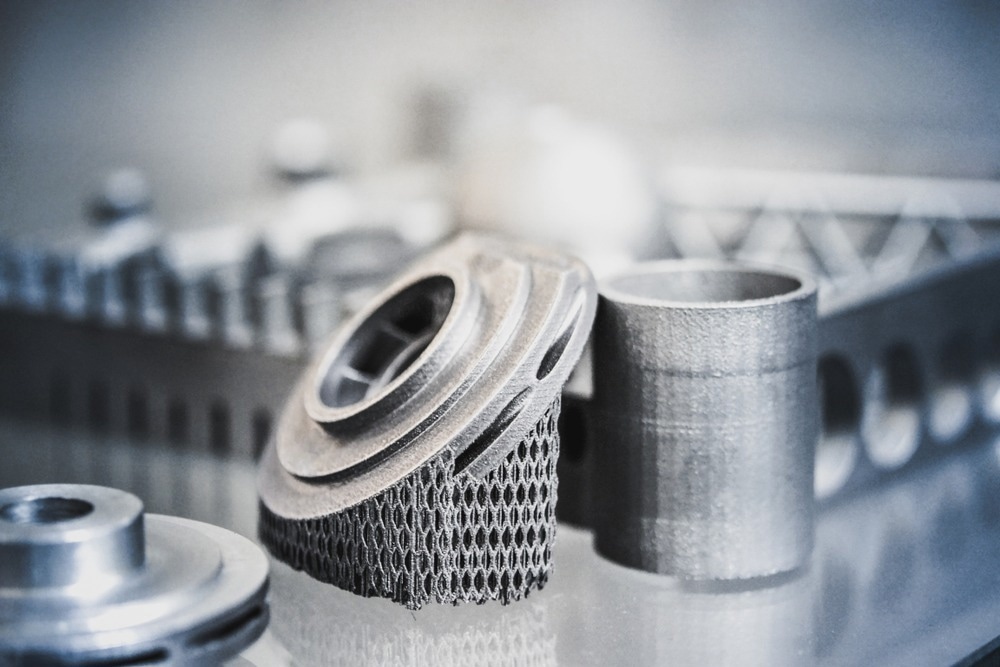The Ti6Al4V alloy has high strength, low density, high fracture toughness, excellent resistance against corrosion, and superior biocompatibility. As the most popular titanium alloy, Ti6Al4V occupies almost half of the market share of the titanium products used today.

Study: Bioactive titanium surfaces enriched with silver nanoparticles through an in-situ reduction: Looking for a balance between cytocompatibility and antibacterial activity. Image Credit: MarinaGrigorivna/Shutterstock.com
An accepted article in Advanced Engineering Materials presented the preparation of a bioactive Ti6Al4V surface with antibacterial and osteoconductive activity, realized via chemical etching-oxidation treatment and silver nanoparticle’s in situ reductions.
A previous report by the team demonstrated that titanium metal’s osteoinductivity could be enhanced via chemical treatment in the presence and absence of silver. Consequently, different parameters were altered in the present work to tune the amount and distribution of silver across the superficial oxide layer.
The resulting samples were characterized using various analytical techniques and evaluated for their silver release, biofilm formation, and cytocompatibility with human osteoblast progenitor cells.
While the silver precursor’s concentration determined the quantity of silver deposited across the surface oxide layer, its addition time during the oxidation treatment affected the dimensions, thickness, and distribution of silver nanoparticles throughout the oxide layer.
Maximum silver ion release occurred after 24 hours and lasted for about 14 days. The subsequent addition of the silver precursors resulted in a sustained silver release for an extended time. While samples with the silver precursor in higher concentration were bacteriocidic and highly cytotoxic, other samples were bacteriostatic and only marginally cytotoxic.
Antibacterial Properties of Silver Nanoparticles
Silver nanoparticles are nanomaterials with dimensions of 1–100 nanometers and have shown a greater capacity and higher surface area than silver in its bulk form. Silver nanoparticles are excellent antimicrobial agents that combat infections caused by gram-positive and gram-negative bacteria, including multidrug-resistant strains.
At the nanoscale, silver nanoparticles exhibit unique electrical, optical, and catalytic properties, which have led to the investigation and fabrication of products for targeted drug delivery, diagnosis, detection, and imaging. However, the exceptional antibacterial activity exhibited by silver nanoparticles, which has attracted the attention of researchers and industries, has shown antimicrobial activity against various infectious and pathogenic microorganisms, including multidrug-resistant bacteria.
In this regard, silver nanoparticles can execute different possible antibacterial mechanisms, including releasing silver ions to obstruct DNA replication and suppress the production of adenosine triphosphate (ATP), reactive oxygen species (ROS) generation, and destruction of the bacterial membrane.
Silver can bind to every biological or chemical compound (phosphates, thiols, amines, and silenols) due to its non-selectivity. Hence, detecting a particular receptor responsible for activating the biological pathway for its antibacterial activity is challenging. Nevertheless, owing to the absence of selectivity, silver nanoparticles exhibit a broad-spectrum activity, making it difficult for bacteria to develop a resistance mechanism.
Silver Nanoparticles Enriched Bioactive Titanium Surfaces
Previously, chemically altered titanium surfaces were used for bone implants in the presence and absence of silver nanoparticles. Although both the chemically treated surfaces were bioactive in terms of precipitating the hydroxyapatite on being exposed to physiological fluids, suppressing bacterial adhesion, and improving the biological response, the incorporation of silver into the oxide layer activated the antibacterial activity.
The present work aimed to explore the effect of silver precursor concentration on the oxidation process. The variation in the precursor concentration was anticipated to differ in the amount and distribution of silver across the oxide layer, consequently affecting the release of silver and the surface density of silver nanoparticles in direct contact with bacteria.
Analysis of the obtained sample's cross-sections with transmission and scanning transmission electron microscopy (TEM and STEM) revealed that the silver nanoparticles were denser on the surface when the silver precursor was added earlier during the chemical treatment. Moreover, silver release in water was higher when a concentrated silver precursor was used during the preparation.
Concentrated silver precursor reduced the viability of floating planktonic bacteria and prevented biofilm formation. However, the resultant samples were highly cytotoxic. Although diluted silver precursor showed weaker effects on planktonic bacteria, the prevention of biofilm colonization remained strong and reduced the cytotoxicity by 50%.
Conclusion
To summarize, the present work demonstrated in situ reduction of silver nanoparticles on the surface of Ti6Al4V (titanium alloy) during the growth of titanium oxide nanostructure, suitable for bone contact applications.
Three different protocols were investigated, including adding additives and a silver precursor at different times of the oxidation process, and the produced samples with silver nanoparticles on the surface were analyzed using various analytical methods. The results revealed that the silver nanoparticles were smaller when the silver precursor was added later during chemical treatment and when added earlier, it resulted in a higher density of silver nanoparticles in the oxide layer.
The results of the present study revealed that it was difficult to compromise cytocompatibility and antibacterial activity in the case of titanium surfaces with tiny silver nanoparticles, and other factors may affect biological characteristics in addition to silver content.
Reference
Cazzola, M et al. (2022), Bioactive titanium surfaces enriched with silver nanoparticles through an in-situ reduction: Looking for a balance between cytocompatibility and antibacterial activity. Advanced Engineering Materials. https://onlinelibrary.wiley.com/doi/10.1002/adem.202200883
Disclaimer: The views expressed here are those of the author expressed in their private capacity and do not necessarily represent the views of AZoM.com Limited T/A AZoNetwork the owner and operator of this website. This disclaimer forms part of the Terms and conditions of use of this website.